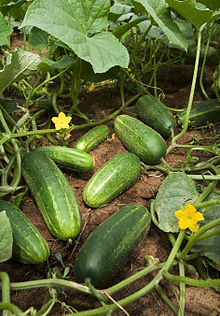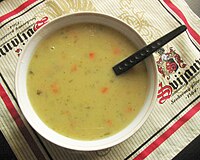A pickled cucumber (commonly known as a pickle in the United States and Canada or generically as gherkins in the United Kingdom) is a cucumber that has been pickled in a brine, vinegar, or other solution and left to ferment for a period of time, by either immersing the cucumbers in an acidic solution or through souring by lacto-fermentation.
Types

Gherkin
A gherkin is not only a pickle of a certain size but also a particular species of cucumber: the West Indian or Burr Gherkin (Cucumis anguria), which produces a somewhat smaller fruit than the garden cucumber (Cucumis sativus>). Standard pickles are made from the Burr Gherkin, but the term gherkin has become loosely used as any small cucumber pickled in a vinegar brine, regardless of the variety of cucumber used.
Cornichon
Cornichons are tart French pickles made from small gherkins pickled in vinegar and tarragon. They traditionally accompany pâtés.
Brined pickles
Brined pickles are prepared using the traditional process of natural fermentation in a brine which makes them grow sour. The brine concentration can vary between 20Â g/litre to more than 40Â g/litre of salt. There is no vinegar used in the brine of naturally fermented pickled cucumbers.
The fermentation process is entirely dependent on the naturally occurring Lactobacillus bacteria that normally cover the skin of a growing cucumber. Since these are routinely removed during commercial harvesting/packing processes, traditionally prepared pickles can only be made from freshly harvested cucumbers, unless the bacteria are artificially replaced.
Typically, small cucumbers are placed in a glass or ceramic vessel or a wooden barrel, together with a variety of spices. Among those traditionally used in many recipes are garlic, horseradish, whole dill stems with umbels and green seeds, white mustard seeds, grape, oak, cherry, blackcurrant and bay laurel leaves, dried allspice fruits, andâ€"most importantlyâ€"salt. The container is then filled with cooled, boiled water and kept under a non-airtight cover (often cloth tied on with string or a rubber band) for several weeks, depending on taste and external temperature. Traditionally stones, also sterilized by boiling, are placed on top of the cucumbers to keep them under the water. The more salt is added the more sour the cucumbers become.
Since they are produced without vinegar, a film of bacteria forms on the top, but this does not indicate they have spoiled, and the film is simply removed. They do not, however, keep as long as cucumbers pickled with vinegar, and usually must be refrigerated. Some commercial manufacturers add vinegar as a preservative.
Kosher dill (US)
A "kosher" dill pickle is not necessarily kosher in the sense that it has been prepared in accordance with Jewish dietary law. Rather, it is a pickle made in the traditional manner of Jewish New York City pickle makers, with generous addition of garlic and dill to a natural salt brine.
In New York terminology, a "full-sour" kosher dill is one that has fully fermented, while a "half-sour," given a shorter stay in the brine, is still crisp and bright green. Elsewhere, these pickles may sometimes be termed "old" and "new" dills.
Dill pickles (not necessarily described as "kosher") have been served in New York City since at least 1899. They are not, however, native to New York; they have been prepared in Russia, Ukraine, Germany and Poland for hundreds of years.
Polish
The Polish-style pickled cucumber (Polish: ogórek kiszony/kwaszony) is a variety developed in the northern parts of Europe. It has been exported worldwide and is found in the cuisines of many countries. It is sour, similar to kosher dills, but tends to be seasoned differently. It is usually preserved in wooden barrels. A cucumber only pickled for a few days is different in taste (less sour) than one pickled for a longer time and is called ogórek małosolny, which literally means 'low-salt cucumber'. This distinction is similar to the one between half- and full-sour types of kosher dills (see above).
Another kind of pickled cucumber, popular in Poland, is ogórek konserwowy ('preserved cucumber') which is rather sweet and vinegary in taste, due to different composition of the preserving solution. It is kept in jars instead of barrels or cans.
Hungarian
In Hungary, while regular vinegar-pickled cucumbers (Hungarian: savanyú uborka) are made during most of the year, during the summer kovászos uborka ("leavened pickles") are made without the use of vinegar. Cucumbers are placed in a glass vessel along with spices (usually dill and garlic), water and salt. Additionally, a slice or two of bread are placed at the top and bottom of the solution, and the container is left to sit in the sun for a few days so the yeast in the bread can help cause a fermentation process.
Lime
Lime pickles are soaked in lime rather than in a salt brine. This is done more to enhance texture (by making them crisper) rather than as a preservative. The lime is then rinsed off the pickles. Vinegar and sugar are often added after the 24-hour soak in lime, along with pickling spices.
Bread and butter
Bread-and-butter pickles are a marinated pickle produced with sliced cucumbers in a solution of vinegar, sugar and spices which may be either be processed by canning or simply chilled as refrigerator pickles. The origin of the name and the spread of their popularity in the United States is attributed to Omar and Cora Fanning, a pair of Illinois cucumber farmers who started selling sweet and sour pickles in the 1920s and filed for the trademark "Fanning's Bread and Butter Pickles" in 1923 (though the recipe and similar ones are probably much older). The story attached to the name is that the Fannings survived rough years by making the pickles with their surplus of undersized cucumbers and bartering them with their grocer for staples such as bread and butter.
Swedish and Danish
Swedish pickled cucumbers (pressgurka) are thinly sliced, mixed with salt and pressed to drain some water from the cucumber slices. Afterwards placed in a jar with a sour-sweet brine of vinegar, sugar, dill and mustard seeds.
Danish cucumber salad (agurkesalat) is similar, but the cucumbers are not pressed and the brine doesn't have parsley. The cucumber salad accompanies meat dishes, especially a roasted chicken dish (gammeldags kylling med agurkesalat), and is used on Danish hot dogs.
There is also the "long time pickles", which calls for some month of cool storing in order to be eatable. In Southern Sweden and Denmark a solution of water, mild acidic vinegar (not made of wine and is clear as water), sugar and the top of dill plants, known as krondill (English: Crown dill) and a little salt. In Sweden this is known as "Ättiksgurka" (English: Vinegar Cucumber) and has a crispy sweet and sour taste. Further north in Sweden, are some of the acidic vinegar and all the sugar replaced with more salt. This is known as "Saltgurka". It's a strange fact that most people who likes "Ättiksgurka" can't stand "Saltgurka" and vice versa. Both "ättiksgurka" and "saltgurka" are used as a minor part of certain dishes.
Kool-Aid pickles
Kool-Aid pickles or "koolickles", enjoyed by children in parts of the Southern United States, are created by soaking dill pickles in a mixture of Kool-Aid and pickle brine.
Nutrition

Like pickled vegetables such as sauerkraut, sour pickled cucumbers (technically a fruit) are low in calories. They also contain a moderate amount of vitamin K, specifically in the form of K1. One 30-gram sour pickled cucumber "spear" offers 12â€"16 µg, or approximately 15â€"20%, of the Recommended Daily Allowance of vitamin K. It also offers three kilocalories, most of which come from carbohydrate. However, most sour pickled cucumbers are also high in sodium; one spear can contain 350â€"500 mg, or 15â€"20% of the American recommended daily limit of 2400 mg.
Sweet pickled cucumbers, including bread-and-butter pickles, are higher in calories due to their sugar content; a similar 30-gram portion may contain 20â€"30 kilocalories. Sweet pickled cucumbers also tend to contain significantly less sodium than sour pickles.
Serving

In the United States, pickles are often served as a side dish accompanying meals. This often takes the form of a "pickle spear", which is a pickled cucumber cut length-wise into quarters or sixths. Pickles may be used as a condiment on a hamburger or other sandwich (usually in slice form), or on a sausage or hot dog in chopped form as pickle relish.
Soured cucumbers are commonly used in a variety of dishesâ€"for example, pickle-stuffed meatloaf, potato salad or chicken saladâ€"or consumed alone as an appetizer.
Pickles are sometimes served alone as festival foods, often on a stick. This is also done in Japan, where it is referred to as "stick pickle" (一本漬, ippon-tsuke).
Dill pickles can be fried, typically deep-fried with a breading or batter surrounding the spear or slice. This is a popular dish in the Southern U.S., and a rising trend elsewhere in the US.
In Russia and Ukraine, pickles are used in rassolnik: a traditional soup made from pickled cucumbers, pearl barley, pork or beef kidneys, and various herbs. The dish is known to have existed as far back as the 15th century, when it was called kalya.
Pickle etymology

The term pickle is derived from the Dutch word pekel, meaning brine. In the U.S. and Canada, the word pickle alone almost always refers to a pickled cucumber (other types of pickles will be described as "pickled onion," "pickled beets," etc.). In the UK pickle generally refers to ploughman's pickle, such as Branston pickle, traditionally served with a ploughman's lunch.
See also
- List of pickled foods
- Pickle soup
- Food portal
References

External links
- Media related to Pickled cucumbers at Wikimedia Commons
- The dictionary definition of pickle at Wiktionary

